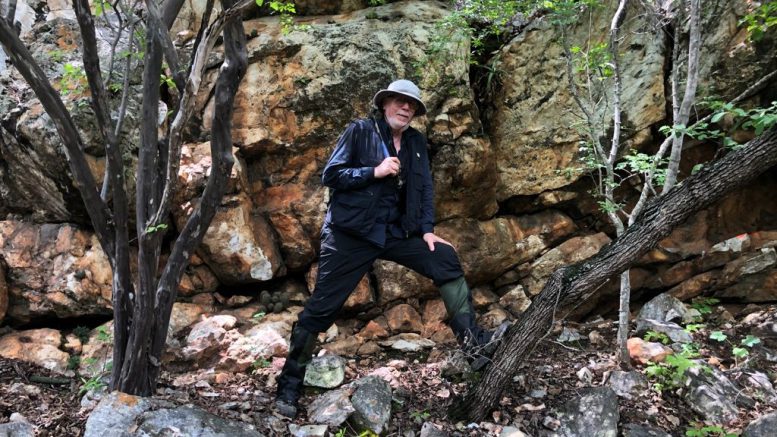With renewed interest in the discovery potential of the eastern Yukon and the western Northwest Territories, accomplished mineral explorer and mining financier Simon Ridgway Rackla Metals (TSXV: RAK) CEO is returning to his roots with a focus on the region’s Tombstone Gold Belt.
Throughout his colourful career, broadly entailing playing poker by night and researching or ‘kicking rocks’ by day, Ridgway and the exploration teams under his guidance have discovered gold deposits in Honduras, Guatemala and Nicaragua and a silver-gold deposit in Mexico.
On the financial side, companies operating under his Gold Group Management umbrella have raised over $450 million for exploration and development projects since 2003.
Ridway was also a founder and former chairman of Fortuna Silver Mines (TSX: FVI) and is credited for the discovery of Cerro Blanco, currently under development by Bluestone Resources (TSX: BSR); a co-founder of Radius Gold (TSXV: RDU), and CEO of Volcanic Gold Mines (TSXV: VG).
But Ridgway started his career as a prospector in the Yukon in the 1970s. And Snowline Gold’s (CSE: SGD) recent unexpected discovery at the Rogue project in the territory led him back to the region.
“I live to be out in the field looking at rocks,” Ridgway tells The Northern Miner in an interview. “However, I discovered early in my career that I have a knack for deducing prospective discovery targets from undertaking desktop research. Canada has an amazing advantage: all prior work data becomes public when a company relinquishes claims, providing a basis for new interpretation by fresh eyes and minds.”
Following Snowline’s significant intrusive related gold discovery last year in the Yukon’s Tombstone Gold Belt, Ridgway and the Rackla team drew on their experience in the district to trace the geology and geophysics 90 km southeast across the Yukon-Northwest Territories border. As a result of this work, the company has recently acquired interests in six gold properties located in the belt, which lies within the Selwyn Basin. It plans to conduct exploration campaigns at several of these this year.
Ridgway started his career exploring the Tombstone Gold Belt for intrusives. This time, he is working some ways further east in an area he didn’t look at before because, for the most part, it was thought the eastern Yukon was not prospective for significant gold deposits.
He explains the significant discoveries in the Tombstone suite of rocks, including Kinross Gold’s (TSX: K) Fort Knox, AK and Victoria Gold’s (TSX: VGCX) Eagle deposit, both had well-established alluvial gold trains to follow to the source.
“Snowline’s discovery is totally different, whether that’s because the erosion level is less in eastern Yukon, or just in that in that particular intrusive – it was not moved until recently, so there’s no real alluvial gold associated with it,” Ridgway says.
“But that drove me back into the region. When I saw the results of Snowline a bit later, I quickly went back to my room and began researching it. And it blatantly seemed obvious to me that the Tombstone suites in the Northwest Territories had not been explored.”
Ridgway immediately began staking claims in the area. Where the current Indigenous land claims situation in the Yukon prevented claim staking, he went across the border to the Northwest Territories, where it appeared no one had thought to stake prospective claims along the same prospective trend.
Frontier exploration
Ridgway says the Tombstone Gold Belt of Yukon and the N.W.T. hosts sizeable reduced-intrusion-related gold system deposits. These gold systems can form world-class deposits hosted in sheeted gold veins forming in the carapace zones of reduced felsic plutons.
Rackla targets the characteristic geochemical signatures for these systems entailing a gold-bismuth-tellurium-tungsten metal assemblage within and surrounding the intrusion, Ridgway explains.
Snowline’s drilling has shown that these intrusive deposits can be discrete, yet multi-million ounces in scale. The use of historic regional datasets provides a roadmap for discovery,” says Ridgway.
Rackla has staked or optioned more than 460 sq. km of exploration claims in the Tombstone Gold Belt comprising the Astro, Hit, SER, Jos, RAK Main, Cinnabar and Rivier projects.

The Tombstone Gold Belt and Rackla’s project locations. Credit: Rackla Metals.
The claims are located between 6 and 26 km east of the Canol Road and Macmillan Pass airstrip, providing relatively good access to the various projects.
Previous work by operators on the Yukon side of the border has found significant stream sediment gold anomalies that appear to be draining several intrusive bodies within the N.W.T. Recent mapping has identified stock-work veining within the intrusive bodies, especially in the recessive areas where the intrusive bodies form valleys, says Ridgway.
Rackla has been working on drill permits for the Rivier project to the south, but the process has advanced slower than anticipated, with permits on the new claims expected in time for its planned multi-project field season this year.
Freshly cashed up following a $3.4-million placement in December, the company plans a multi-project aggressive program of prospecting, mapping, geophysics, and drilling this year. The Astro property, one of the most prospective in the group, has a valid drill permit and drill-ready targets, and the company is working on drill permits for the remaining projects.
Drilling will be guided by the results of a detailed airborne magnetic program, prospecting and geological mapping conducted by Rackla last year.
The company last traded in Toronto at 34¢ per share, giving it a market cap of $20 million.


Be the first to comment on "Exploration doyen Simon Ridgway comes full circle in the Yukon with Rackla Metals"